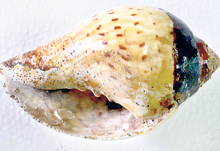Visiting the beach as a child, I always looked for a ‘Valampuri’- a chank shell coiled to the reverse side which is said to bring good luck to whoever owns it. But chanks are rare on our beaches now, for unsustainable fishing has severely depleted the Indian conch, which produces the chank shells.
The Customs Bio-Diversity Unit recently raided a chank shipment which contained 40% of undersized chanks ready for export. Chank fishery is permitted in Sri Lanka, but by law, only chanks larger than 7 cm in diameter can be collected.
The size is regulated to ensure sustainability of the species, which has a slow reproduction rate. Traditionally a wooden gauge is used and shells which pass through the gauge are graded as undersized and confiscated to discourage divers from bringing immature animals ashore. But this detection by the Customs raises questions about the effectiveness of these regulations.
Chank is the shell of Indian Conch – a mollusc (kind of a snail scientifically classified as Xancus pyrum) that lives in the sandy beds of the Indian Ocean. The conch is brownish in colour when in the sea as its shell is covered by a skin. Once collected, these molluscs are stockpiled for about a month until they decompose, giving out a foul smell.
“We did not have to ask anybody to guide us to the sites. The unbearable odour led us to the chank fishery sites,” said environmental lawyer Jagath Gunawardene who raised the sustainability issue in the early ’90s after studying chank fishing in Hambantota and Kirinda. It is now clear that those warnings were not heeded.
Chank fishery was traditionally done by a Muslim community living in the northern parts of the country believed to be of North African origin who also did pearl fishing in Mannar. The main markets for chank are India and Bangladesh where the shells are used to make chank bangles, traditionally worn by married Bengali Hindu women. Archaeological evidence indicates that such bangles were worn and bangle-making workshops established in India and Sri Lanka 2000 years ago.
The shell is also known as the Sacred Chank because of its importance in both the Hindu and Buddhist religions, where it is used as a ceremonial instrument. The rare and costly 'valampuri' chanks are especially venerated.
Earlier chanks were collected on a small scale. But the export of containerloads of chank has set the alarm bells ringing. Collection was first done in deeper water beyond the coral reefs. After chank fishing is finished at one site, fishermen would move on to deeper waters.
But the slow reproduction rate of the Indian Conch makes the recovery of the population painfully slow. A fish population will recover very fast, once a site is left alone. But the harm has been done when a site has been over-fished for chanks. “Perhaps it will take as long as 50 – 100 years for a site to fully recover,” says marine biologist Prasanna Weerakkodi.
A regular diver, he has seen the depletion of the Indian Conch population everywhere in Sri Lankan waters. Earlier, chank collection was even done in areas like Wellawatte, but you rarely find a chank these days in these waters, Mr. Weerakkodi said. Chank fishing is now done in deeper waters even at depths of 150 ft.
Regulations were imposed on chank fishing as early as 1890 through the Chank Ordinance that set out specifically how chank fishing should be practised. But this Ordinance was repealed by the 1996 Fisheries Act. The 1996 Act did not provide much protection to chanks but under the latest regulations in 2003, collection of chanks less than 7cm in diameter is prohibited.
Earlier chank merchants did not purchase smaller sized chanks. Nowadays, the larger shells are exported and the smaller shells sold to the local market, where they are used to make ornaments. A chank fisherman needs a licence to collect the shells and a special permit to export. According to Customs officials, earlier a few container- loads were sent out every month, but it is now down to barely a container a month.
Samantha Gunasekera, head of the Customs Biodiversity Unit points out the need to monitor Chank Fishery operations from the ground level - from the point where fishing is done. “How was it that a shipment which contains 40% of undersized chanks got an export permit from the fisheries authorities?” he asks.
A ‘Valampuri’ is said to bring good fortune. How unfortunate, that the species producing the Valampuri is now under threat. |


